Marketing and Management Report: InterContinental Hotels Analysis
VerifiedAdded on 2023/06/03
|27
|7175
|377
Report
AI Summary
This report analyzes the marketing and management strategies of InterContinental Hotels Group (IHG), focusing on segmentation, targeting, and positioning (STP). Part A provides a comprehensive literature review on STP, defining key concepts and exploring different segmentation types (geographic, demographic, psychographic, and behavioral) along with targeting approaches (undifferentiated and differentiated marketing). Part B applies these concepts to IHG, examining its market segmentation strategy, evaluating the advantages and disadvantages of its diverse brand portfolio, and recommending positioning strategies for Holiday Inn and Holiday Inn Express. The report includes a competitive analysis, an assessment of points of parity (POPs) and points of difference (PODs), and a perceptual map for one of IHG's brands, providing insights into IHG's marketing approach and strategic recommendations. The report is based on the "InterContinental Hotels Group PLC: Holiday Inn Division" case study and aims to apply market segmentation and target marketing strategies considering the product life cycle to ensure updated product offerings.
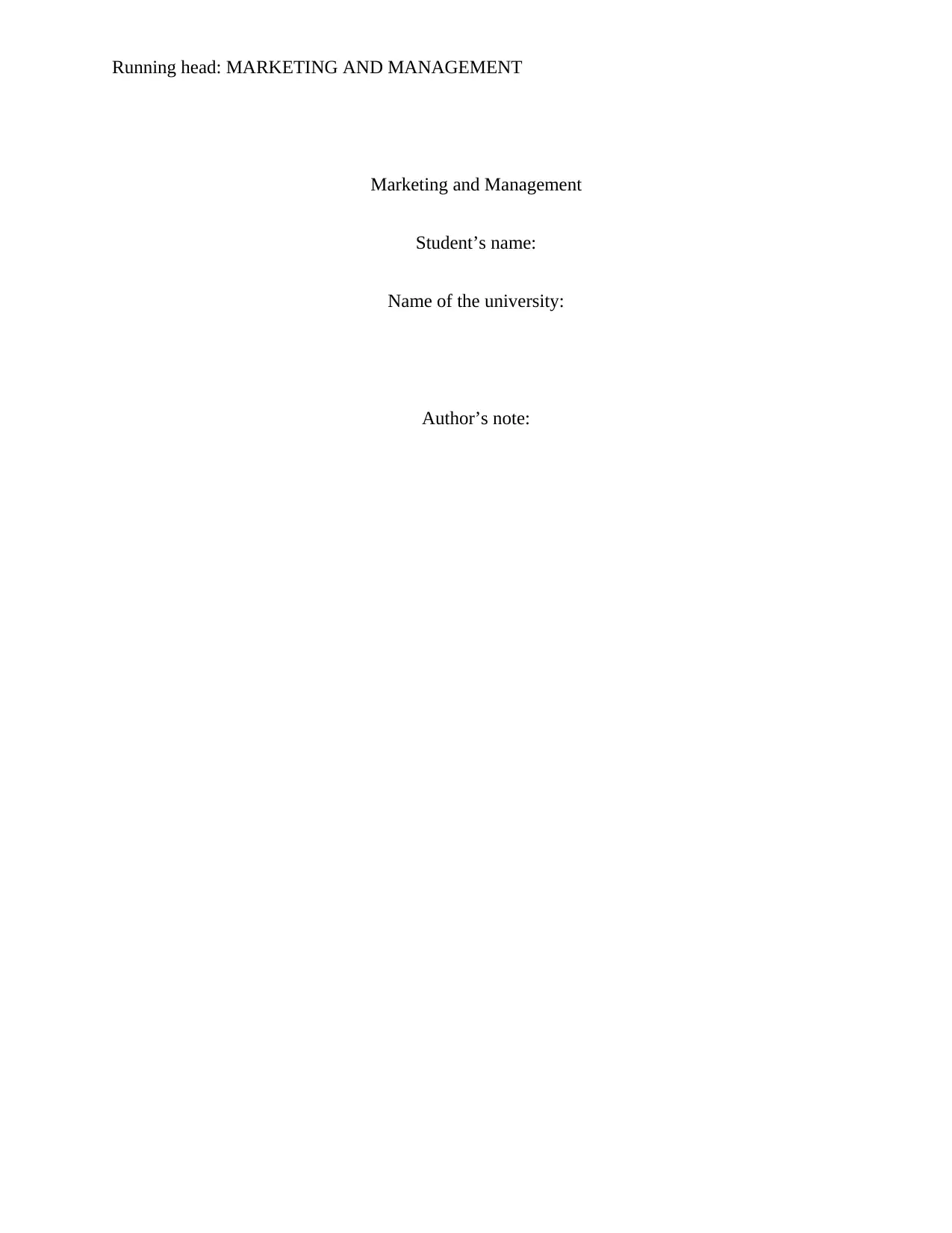
Running head: MARKETING AND MANAGEMENT
Marketing and Management
Student’s name:
Name of the university:
Author’s note:
Marketing and Management
Student’s name:
Name of the university:
Author’s note:
Paraphrase This Document
Need a fresh take? Get an instant paraphrase of this document with our AI Paraphraser
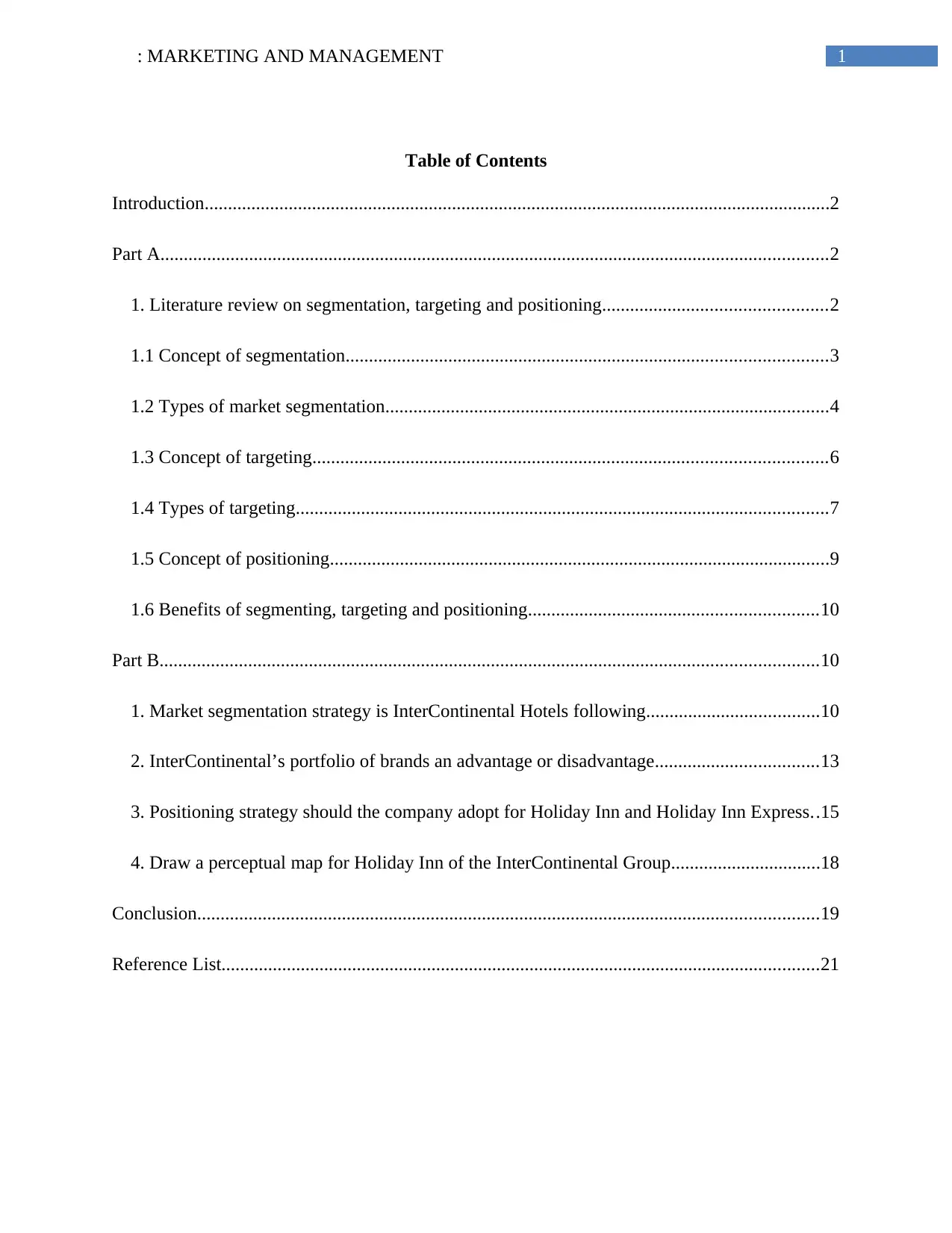
1: MARKETING AND MANAGEMENT
Table of Contents
Introduction......................................................................................................................................2
Part A...............................................................................................................................................2
1. Literature review on segmentation, targeting and positioning................................................2
1.1 Concept of segmentation.......................................................................................................3
1.2 Types of market segmentation...............................................................................................4
1.3 Concept of targeting..............................................................................................................6
1.4 Types of targeting..................................................................................................................7
1.5 Concept of positioning...........................................................................................................9
1.6 Benefits of segmenting, targeting and positioning..............................................................10
Part B.............................................................................................................................................10
1. Market segmentation strategy is InterContinental Hotels following.....................................10
2. InterContinental’s portfolio of brands an advantage or disadvantage...................................13
3. Positioning strategy should the company adopt for Holiday Inn and Holiday Inn Express..15
4. Draw a perceptual map for Holiday Inn of the InterContinental Group................................18
Conclusion.....................................................................................................................................19
Reference List................................................................................................................................21
Table of Contents
Introduction......................................................................................................................................2
Part A...............................................................................................................................................2
1. Literature review on segmentation, targeting and positioning................................................2
1.1 Concept of segmentation.......................................................................................................3
1.2 Types of market segmentation...............................................................................................4
1.3 Concept of targeting..............................................................................................................6
1.4 Types of targeting..................................................................................................................7
1.5 Concept of positioning...........................................................................................................9
1.6 Benefits of segmenting, targeting and positioning..............................................................10
Part B.............................................................................................................................................10
1. Market segmentation strategy is InterContinental Hotels following.....................................10
2. InterContinental’s portfolio of brands an advantage or disadvantage...................................13
3. Positioning strategy should the company adopt for Holiday Inn and Holiday Inn Express..15
4. Draw a perceptual map for Holiday Inn of the InterContinental Group................................18
Conclusion.....................................................................................................................................19
Reference List................................................................................................................................21
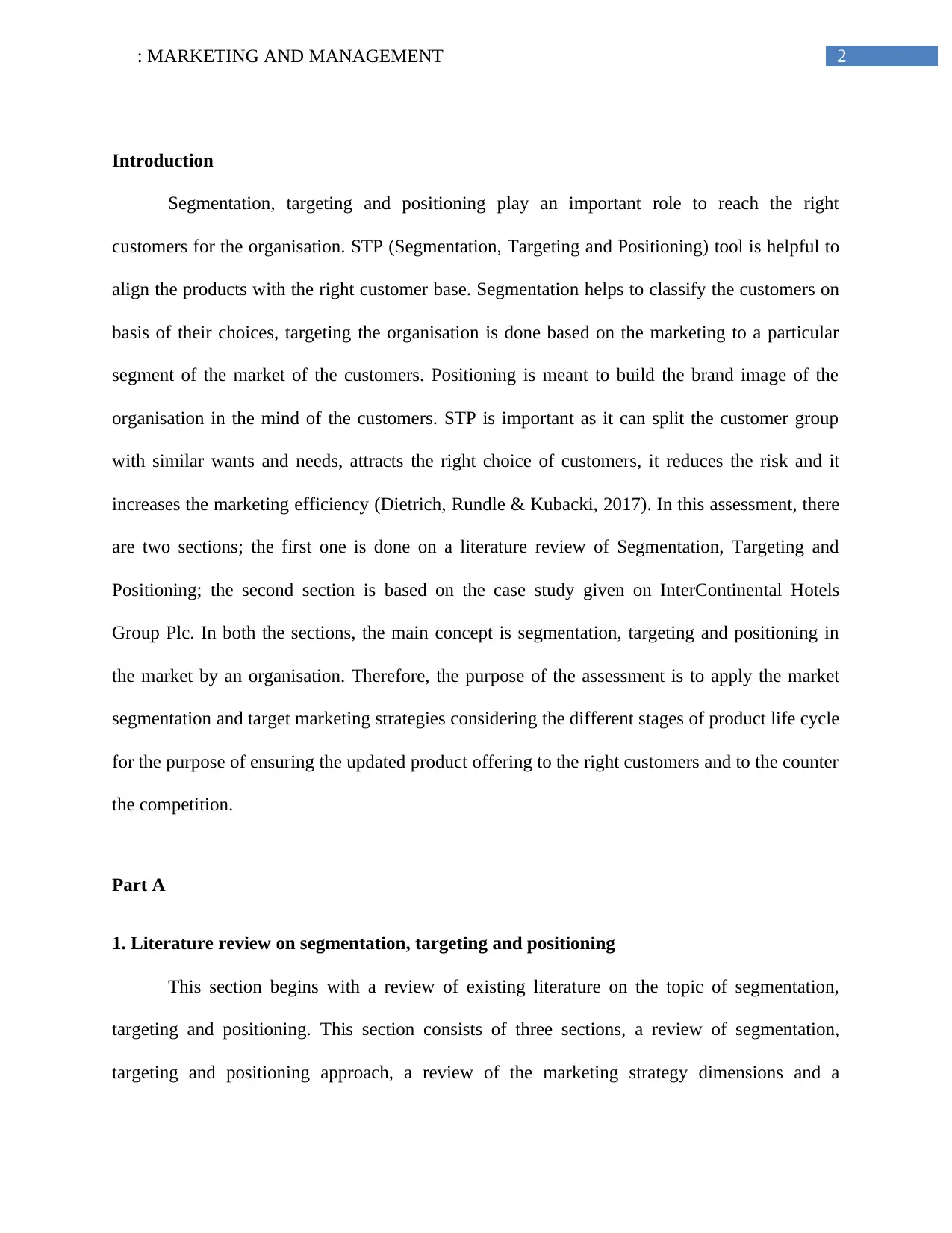
2: MARKETING AND MANAGEMENT
Introduction
Segmentation, targeting and positioning play an important role to reach the right
customers for the organisation. STP (Segmentation, Targeting and Positioning) tool is helpful to
align the products with the right customer base. Segmentation helps to classify the customers on
basis of their choices, targeting the organisation is done based on the marketing to a particular
segment of the market of the customers. Positioning is meant to build the brand image of the
organisation in the mind of the customers. STP is important as it can split the customer group
with similar wants and needs, attracts the right choice of customers, it reduces the risk and it
increases the marketing efficiency (Dietrich, Rundle & Kubacki, 2017). In this assessment, there
are two sections; the first one is done on a literature review of Segmentation, Targeting and
Positioning; the second section is based on the case study given on InterContinental Hotels
Group Plc. In both the sections, the main concept is segmentation, targeting and positioning in
the market by an organisation. Therefore, the purpose of the assessment is to apply the market
segmentation and target marketing strategies considering the different stages of product life cycle
for the purpose of ensuring the updated product offering to the right customers and to the counter
the competition.
Part A
1. Literature review on segmentation, targeting and positioning
This section begins with a review of existing literature on the topic of segmentation,
targeting and positioning. This section consists of three sections, a review of segmentation,
targeting and positioning approach, a review of the marketing strategy dimensions and a
Introduction
Segmentation, targeting and positioning play an important role to reach the right
customers for the organisation. STP (Segmentation, Targeting and Positioning) tool is helpful to
align the products with the right customer base. Segmentation helps to classify the customers on
basis of their choices, targeting the organisation is done based on the marketing to a particular
segment of the market of the customers. Positioning is meant to build the brand image of the
organisation in the mind of the customers. STP is important as it can split the customer group
with similar wants and needs, attracts the right choice of customers, it reduces the risk and it
increases the marketing efficiency (Dietrich, Rundle & Kubacki, 2017). In this assessment, there
are two sections; the first one is done on a literature review of Segmentation, Targeting and
Positioning; the second section is based on the case study given on InterContinental Hotels
Group Plc. In both the sections, the main concept is segmentation, targeting and positioning in
the market by an organisation. Therefore, the purpose of the assessment is to apply the market
segmentation and target marketing strategies considering the different stages of product life cycle
for the purpose of ensuring the updated product offering to the right customers and to the counter
the competition.
Part A
1. Literature review on segmentation, targeting and positioning
This section begins with a review of existing literature on the topic of segmentation,
targeting and positioning. This section consists of three sections, a review of segmentation,
targeting and positioning approach, a review of the marketing strategy dimensions and a
⊘ This is a preview!⊘
Do you want full access?
Subscribe today to unlock all pages.

Trusted by 1+ million students worldwide
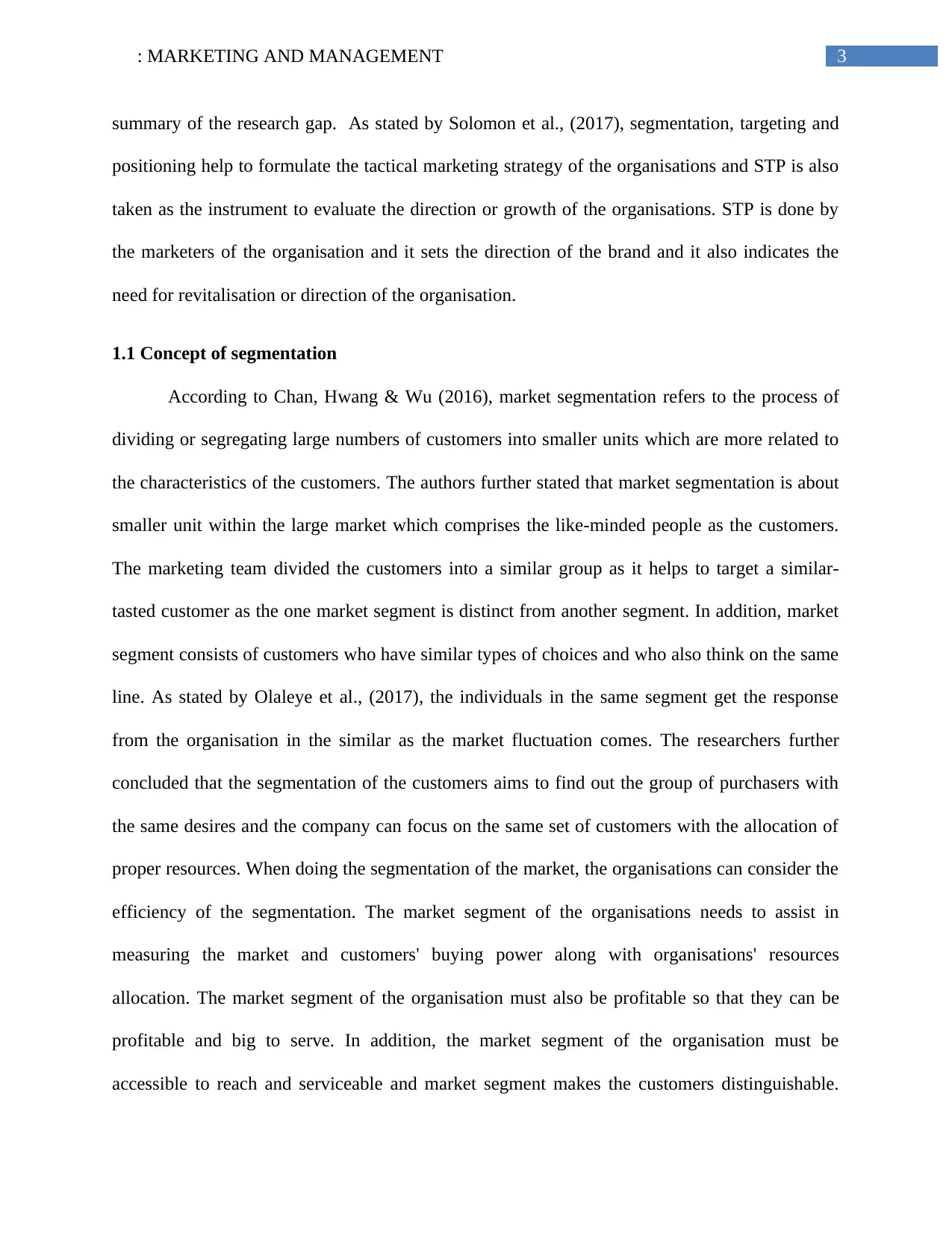
3: MARKETING AND MANAGEMENT
summary of the research gap. As stated by Solomon et al., (2017), segmentation, targeting and
positioning help to formulate the tactical marketing strategy of the organisations and STP is also
taken as the instrument to evaluate the direction or growth of the organisations. STP is done by
the marketers of the organisation and it sets the direction of the brand and it also indicates the
need for revitalisation or direction of the organisation.
1.1 Concept of segmentation
According to Chan, Hwang & Wu (2016), market segmentation refers to the process of
dividing or segregating large numbers of customers into smaller units which are more related to
the characteristics of the customers. The authors further stated that market segmentation is about
smaller unit within the large market which comprises the like-minded people as the customers.
The marketing team divided the customers into a similar group as it helps to target a similar-
tasted customer as the one market segment is distinct from another segment. In addition, market
segment consists of customers who have similar types of choices and who also think on the same
line. As stated by Olaleye et al., (2017), the individuals in the same segment get the response
from the organisation in the similar as the market fluctuation comes. The researchers further
concluded that the segmentation of the customers aims to find out the group of purchasers with
the same desires and the company can focus on the same set of customers with the allocation of
proper resources. When doing the segmentation of the market, the organisations can consider the
efficiency of the segmentation. The market segment of the organisations needs to assist in
measuring the market and customers' buying power along with organisations' resources
allocation. The market segment of the organisation must also be profitable so that they can be
profitable and big to serve. In addition, the market segment of the organisation must be
accessible to reach and serviceable and market segment makes the customers distinguishable.
summary of the research gap. As stated by Solomon et al., (2017), segmentation, targeting and
positioning help to formulate the tactical marketing strategy of the organisations and STP is also
taken as the instrument to evaluate the direction or growth of the organisations. STP is done by
the marketers of the organisation and it sets the direction of the brand and it also indicates the
need for revitalisation or direction of the organisation.
1.1 Concept of segmentation
According to Chan, Hwang & Wu (2016), market segmentation refers to the process of
dividing or segregating large numbers of customers into smaller units which are more related to
the characteristics of the customers. The authors further stated that market segmentation is about
smaller unit within the large market which comprises the like-minded people as the customers.
The marketing team divided the customers into a similar group as it helps to target a similar-
tasted customer as the one market segment is distinct from another segment. In addition, market
segment consists of customers who have similar types of choices and who also think on the same
line. As stated by Olaleye et al., (2017), the individuals in the same segment get the response
from the organisation in the similar as the market fluctuation comes. The researchers further
concluded that the segmentation of the customers aims to find out the group of purchasers with
the same desires and the company can focus on the same set of customers with the allocation of
proper resources. When doing the segmentation of the market, the organisations can consider the
efficiency of the segmentation. The market segment of the organisations needs to assist in
measuring the market and customers' buying power along with organisations' resources
allocation. The market segment of the organisation must also be profitable so that they can be
profitable and big to serve. In addition, the market segment of the organisation must be
accessible to reach and serviceable and market segment makes the customers distinguishable.
Paraphrase This Document
Need a fresh take? Get an instant paraphrase of this document with our AI Paraphraser
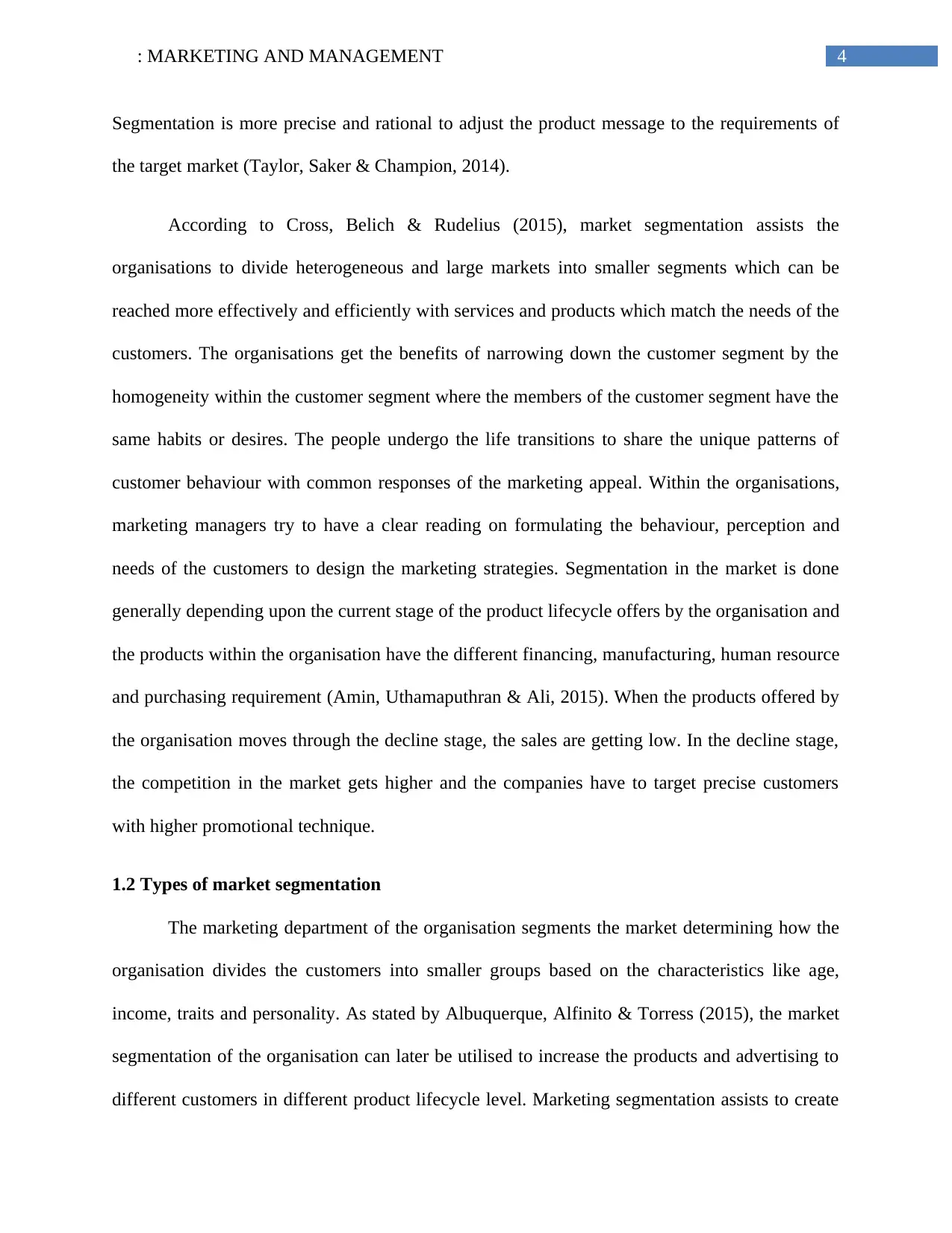
4: MARKETING AND MANAGEMENT
Segmentation is more precise and rational to adjust the product message to the requirements of
the target market (Taylor, Saker & Champion, 2014).
According to Cross, Belich & Rudelius (2015), market segmentation assists the
organisations to divide heterogeneous and large markets into smaller segments which can be
reached more effectively and efficiently with services and products which match the needs of the
customers. The organisations get the benefits of narrowing down the customer segment by the
homogeneity within the customer segment where the members of the customer segment have the
same habits or desires. The people undergo the life transitions to share the unique patterns of
customer behaviour with common responses of the marketing appeal. Within the organisations,
marketing managers try to have a clear reading on formulating the behaviour, perception and
needs of the customers to design the marketing strategies. Segmentation in the market is done
generally depending upon the current stage of the product lifecycle offers by the organisation and
the products within the organisation have the different financing, manufacturing, human resource
and purchasing requirement (Amin, Uthamaputhran & Ali, 2015). When the products offered by
the organisation moves through the decline stage, the sales are getting low. In the decline stage,
the competition in the market gets higher and the companies have to target precise customers
with higher promotional technique.
1.2 Types of market segmentation
The marketing department of the organisation segments the market determining how the
organisation divides the customers into smaller groups based on the characteristics like age,
income, traits and personality. As stated by Albuquerque, Alfinito & Torress (2015), the market
segmentation of the organisation can later be utilised to increase the products and advertising to
different customers in different product lifecycle level. Marketing segmentation assists to create
Segmentation is more precise and rational to adjust the product message to the requirements of
the target market (Taylor, Saker & Champion, 2014).
According to Cross, Belich & Rudelius (2015), market segmentation assists the
organisations to divide heterogeneous and large markets into smaller segments which can be
reached more effectively and efficiently with services and products which match the needs of the
customers. The organisations get the benefits of narrowing down the customer segment by the
homogeneity within the customer segment where the members of the customer segment have the
same habits or desires. The people undergo the life transitions to share the unique patterns of
customer behaviour with common responses of the marketing appeal. Within the organisations,
marketing managers try to have a clear reading on formulating the behaviour, perception and
needs of the customers to design the marketing strategies. Segmentation in the market is done
generally depending upon the current stage of the product lifecycle offers by the organisation and
the products within the organisation have the different financing, manufacturing, human resource
and purchasing requirement (Amin, Uthamaputhran & Ali, 2015). When the products offered by
the organisation moves through the decline stage, the sales are getting low. In the decline stage,
the competition in the market gets higher and the companies have to target precise customers
with higher promotional technique.
1.2 Types of market segmentation
The marketing department of the organisation segments the market determining how the
organisation divides the customers into smaller groups based on the characteristics like age,
income, traits and personality. As stated by Albuquerque, Alfinito & Torress (2015), the market
segmentation of the organisation can later be utilised to increase the products and advertising to
different customers in different product lifecycle level. Marketing segmentation assists to create
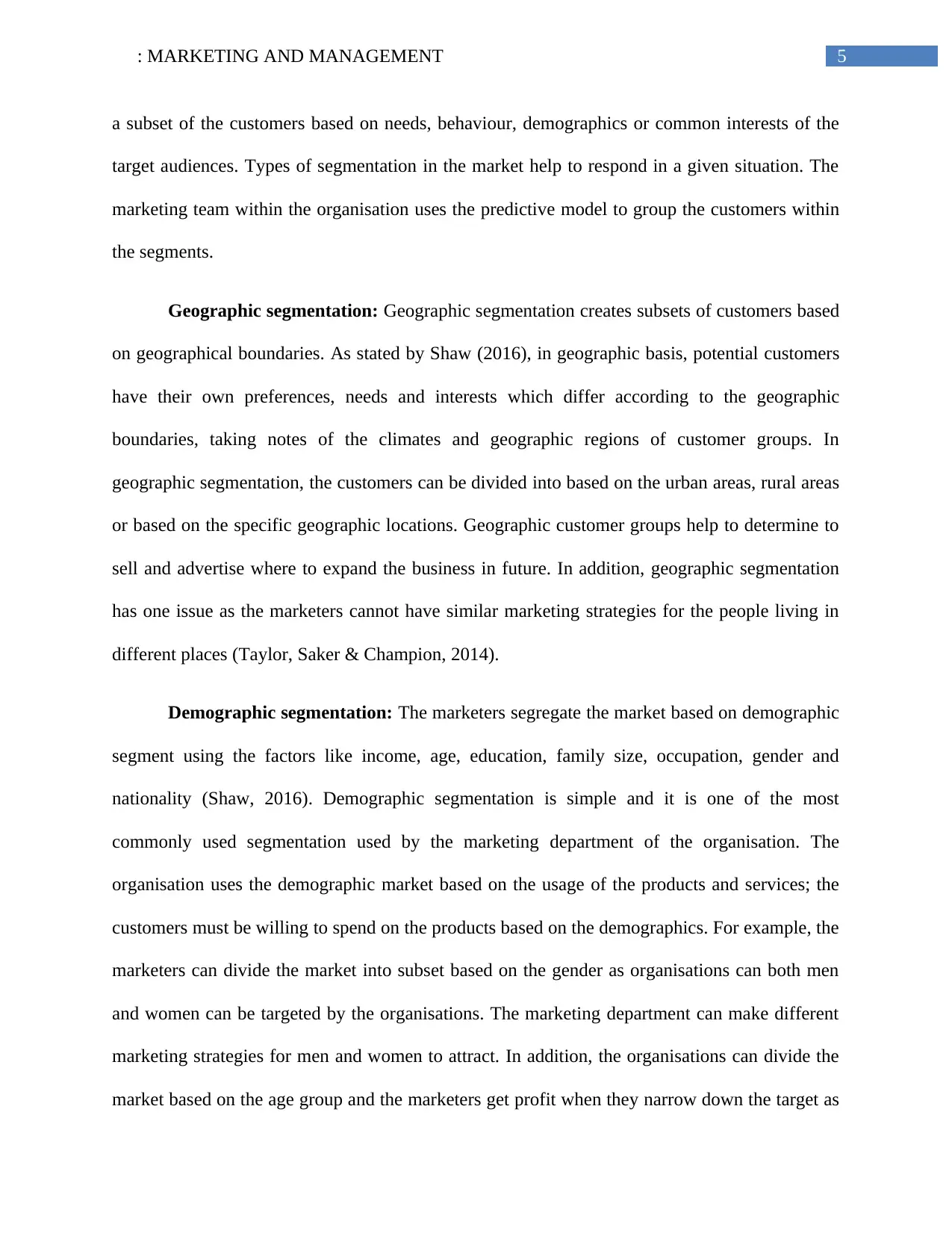
5: MARKETING AND MANAGEMENT
a subset of the customers based on needs, behaviour, demographics or common interests of the
target audiences. Types of segmentation in the market help to respond in a given situation. The
marketing team within the organisation uses the predictive model to group the customers within
the segments.
Geographic segmentation: Geographic segmentation creates subsets of customers based
on geographical boundaries. As stated by Shaw (2016), in geographic basis, potential customers
have their own preferences, needs and interests which differ according to the geographic
boundaries, taking notes of the climates and geographic regions of customer groups. In
geographic segmentation, the customers can be divided into based on the urban areas, rural areas
or based on the specific geographic locations. Geographic customer groups help to determine to
sell and advertise where to expand the business in future. In addition, geographic segmentation
has one issue as the marketers cannot have similar marketing strategies for the people living in
different places (Taylor, Saker & Champion, 2014).
Demographic segmentation: The marketers segregate the market based on demographic
segment using the factors like income, age, education, family size, occupation, gender and
nationality (Shaw, 2016). Demographic segmentation is simple and it is one of the most
commonly used segmentation used by the marketing department of the organisation. The
organisation uses the demographic market based on the usage of the products and services; the
customers must be willing to spend on the products based on the demographics. For example, the
marketers can divide the market into subset based on the gender as organisations can both men
and women can be targeted by the organisations. The marketing department can make different
marketing strategies for men and women to attract. In addition, the organisations can divide the
market based on the age group and the marketers get profit when they narrow down the target as
a subset of the customers based on needs, behaviour, demographics or common interests of the
target audiences. Types of segmentation in the market help to respond in a given situation. The
marketing team within the organisation uses the predictive model to group the customers within
the segments.
Geographic segmentation: Geographic segmentation creates subsets of customers based
on geographical boundaries. As stated by Shaw (2016), in geographic basis, potential customers
have their own preferences, needs and interests which differ according to the geographic
boundaries, taking notes of the climates and geographic regions of customer groups. In
geographic segmentation, the customers can be divided into based on the urban areas, rural areas
or based on the specific geographic locations. Geographic customer groups help to determine to
sell and advertise where to expand the business in future. In addition, geographic segmentation
has one issue as the marketers cannot have similar marketing strategies for the people living in
different places (Taylor, Saker & Champion, 2014).
Demographic segmentation: The marketers segregate the market based on demographic
segment using the factors like income, age, education, family size, occupation, gender and
nationality (Shaw, 2016). Demographic segmentation is simple and it is one of the most
commonly used segmentation used by the marketing department of the organisation. The
organisation uses the demographic market based on the usage of the products and services; the
customers must be willing to spend on the products based on the demographics. For example, the
marketers can divide the market into subset based on the gender as organisations can both men
and women can be targeted by the organisations. The marketing department can make different
marketing strategies for men and women to attract. In addition, the organisations can divide the
market based on the age group and the marketers get profit when they narrow down the target as
⊘ This is a preview!⊘
Do you want full access?
Subscribe today to unlock all pages.

Trusted by 1+ million students worldwide
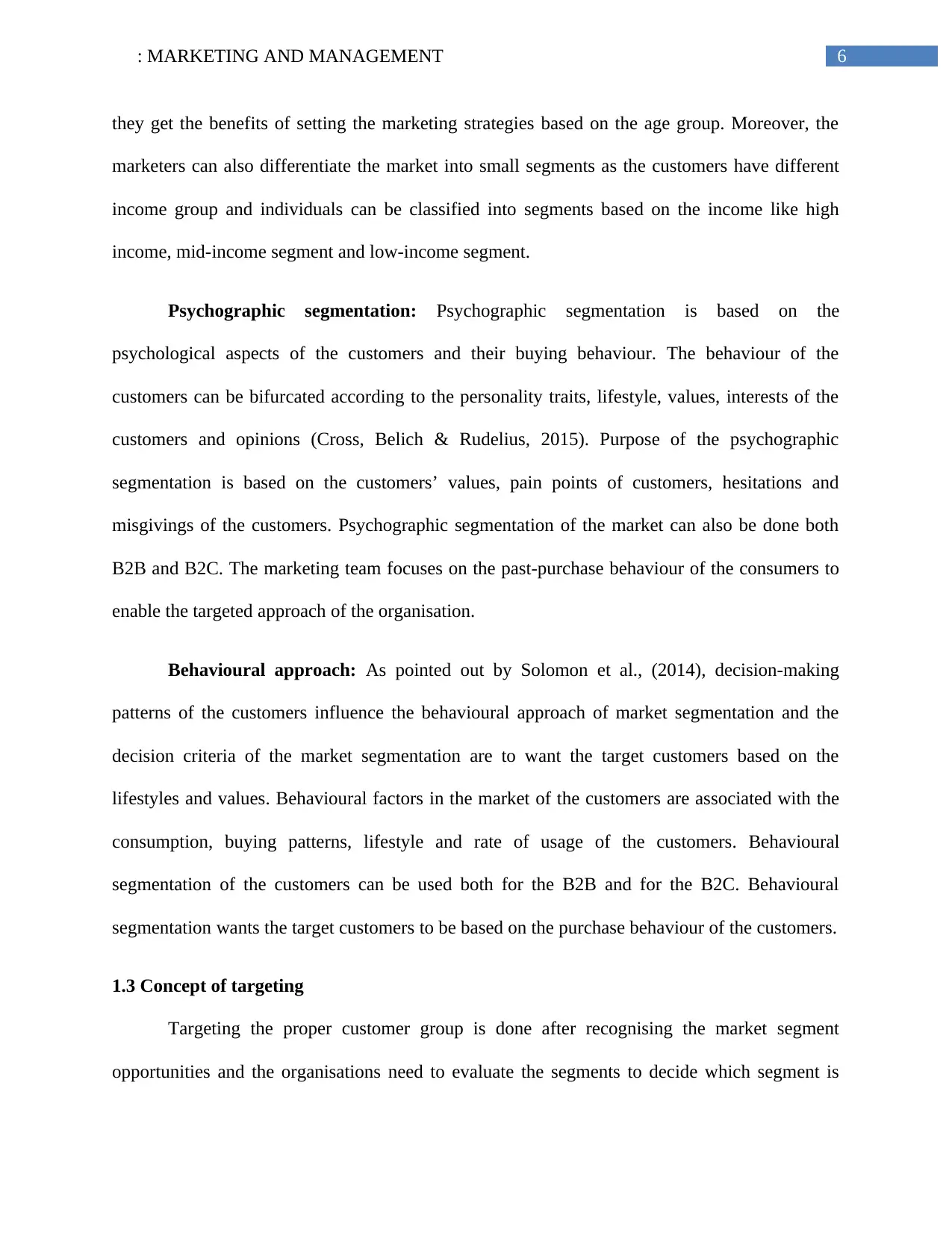
6: MARKETING AND MANAGEMENT
they get the benefits of setting the marketing strategies based on the age group. Moreover, the
marketers can also differentiate the market into small segments as the customers have different
income group and individuals can be classified into segments based on the income like high
income, mid-income segment and low-income segment.
Psychographic segmentation: Psychographic segmentation is based on the
psychological aspects of the customers and their buying behaviour. The behaviour of the
customers can be bifurcated according to the personality traits, lifestyle, values, interests of the
customers and opinions (Cross, Belich & Rudelius, 2015). Purpose of the psychographic
segmentation is based on the customers’ values, pain points of customers, hesitations and
misgivings of the customers. Psychographic segmentation of the market can also be done both
B2B and B2C. The marketing team focuses on the past-purchase behaviour of the consumers to
enable the targeted approach of the organisation.
Behavioural approach: As pointed out by Solomon et al., (2014), decision-making
patterns of the customers influence the behavioural approach of market segmentation and the
decision criteria of the market segmentation are to want the target customers based on the
lifestyles and values. Behavioural factors in the market of the customers are associated with the
consumption, buying patterns, lifestyle and rate of usage of the customers. Behavioural
segmentation of the customers can be used both for the B2B and for the B2C. Behavioural
segmentation wants the target customers to be based on the purchase behaviour of the customers.
1.3 Concept of targeting
Targeting the proper customer group is done after recognising the market segment
opportunities and the organisations need to evaluate the segments to decide which segment is
they get the benefits of setting the marketing strategies based on the age group. Moreover, the
marketers can also differentiate the market into small segments as the customers have different
income group and individuals can be classified into segments based on the income like high
income, mid-income segment and low-income segment.
Psychographic segmentation: Psychographic segmentation is based on the
psychological aspects of the customers and their buying behaviour. The behaviour of the
customers can be bifurcated according to the personality traits, lifestyle, values, interests of the
customers and opinions (Cross, Belich & Rudelius, 2015). Purpose of the psychographic
segmentation is based on the customers’ values, pain points of customers, hesitations and
misgivings of the customers. Psychographic segmentation of the market can also be done both
B2B and B2C. The marketing team focuses on the past-purchase behaviour of the consumers to
enable the targeted approach of the organisation.
Behavioural approach: As pointed out by Solomon et al., (2014), decision-making
patterns of the customers influence the behavioural approach of market segmentation and the
decision criteria of the market segmentation are to want the target customers based on the
lifestyles and values. Behavioural factors in the market of the customers are associated with the
consumption, buying patterns, lifestyle and rate of usage of the customers. Behavioural
segmentation of the customers can be used both for the B2B and for the B2C. Behavioural
segmentation wants the target customers to be based on the purchase behaviour of the customers.
1.3 Concept of targeting
Targeting the proper customer group is done after recognising the market segment
opportunities and the organisations need to evaluate the segments to decide which segment is
Paraphrase This Document
Need a fresh take? Get an instant paraphrase of this document with our AI Paraphraser
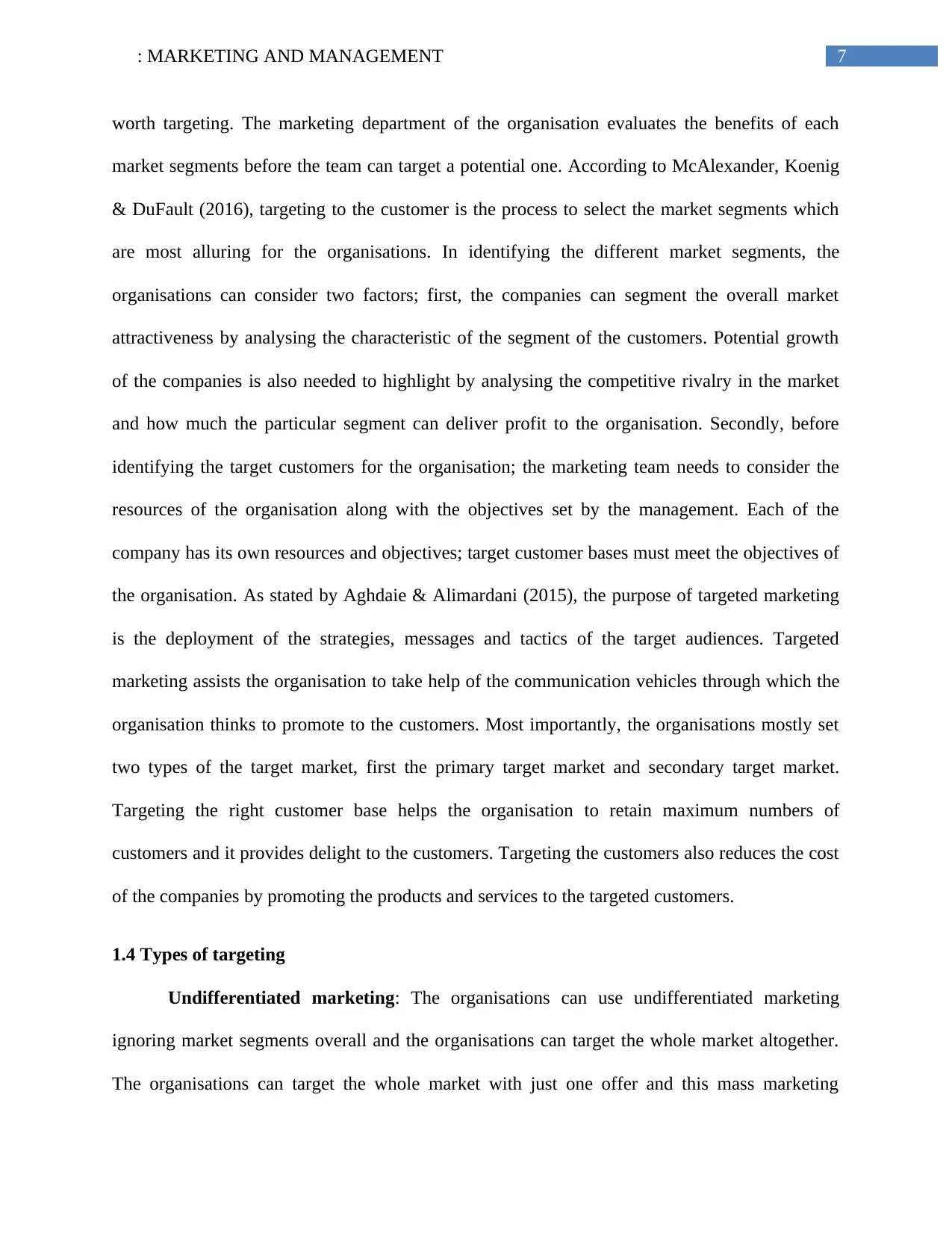
7: MARKETING AND MANAGEMENT
worth targeting. The marketing department of the organisation evaluates the benefits of each
market segments before the team can target a potential one. According to McAlexander, Koenig
& DuFault (2016), targeting to the customer is the process to select the market segments which
are most alluring for the organisations. In identifying the different market segments, the
organisations can consider two factors; first, the companies can segment the overall market
attractiveness by analysing the characteristic of the segment of the customers. Potential growth
of the companies is also needed to highlight by analysing the competitive rivalry in the market
and how much the particular segment can deliver profit to the organisation. Secondly, before
identifying the target customers for the organisation; the marketing team needs to consider the
resources of the organisation along with the objectives set by the management. Each of the
company has its own resources and objectives; target customer bases must meet the objectives of
the organisation. As stated by Aghdaie & Alimardani (2015), the purpose of targeted marketing
is the deployment of the strategies, messages and tactics of the target audiences. Targeted
marketing assists the organisation to take help of the communication vehicles through which the
organisation thinks to promote to the customers. Most importantly, the organisations mostly set
two types of the target market, first the primary target market and secondary target market.
Targeting the right customer base helps the organisation to retain maximum numbers of
customers and it provides delight to the customers. Targeting the customers also reduces the cost
of the companies by promoting the products and services to the targeted customers.
1.4 Types of targeting
Undifferentiated marketing: The organisations can use undifferentiated marketing
ignoring market segments overall and the organisations can target the whole market altogether.
The organisations can target the whole market with just one offer and this mass marketing
worth targeting. The marketing department of the organisation evaluates the benefits of each
market segments before the team can target a potential one. According to McAlexander, Koenig
& DuFault (2016), targeting to the customer is the process to select the market segments which
are most alluring for the organisations. In identifying the different market segments, the
organisations can consider two factors; first, the companies can segment the overall market
attractiveness by analysing the characteristic of the segment of the customers. Potential growth
of the companies is also needed to highlight by analysing the competitive rivalry in the market
and how much the particular segment can deliver profit to the organisation. Secondly, before
identifying the target customers for the organisation; the marketing team needs to consider the
resources of the organisation along with the objectives set by the management. Each of the
company has its own resources and objectives; target customer bases must meet the objectives of
the organisation. As stated by Aghdaie & Alimardani (2015), the purpose of targeted marketing
is the deployment of the strategies, messages and tactics of the target audiences. Targeted
marketing assists the organisation to take help of the communication vehicles through which the
organisation thinks to promote to the customers. Most importantly, the organisations mostly set
two types of the target market, first the primary target market and secondary target market.
Targeting the right customer base helps the organisation to retain maximum numbers of
customers and it provides delight to the customers. Targeting the customers also reduces the cost
of the companies by promoting the products and services to the targeted customers.
1.4 Types of targeting
Undifferentiated marketing: The organisations can use undifferentiated marketing
ignoring market segments overall and the organisations can target the whole market altogether.
The organisations can target the whole market with just one offer and this mass marketing
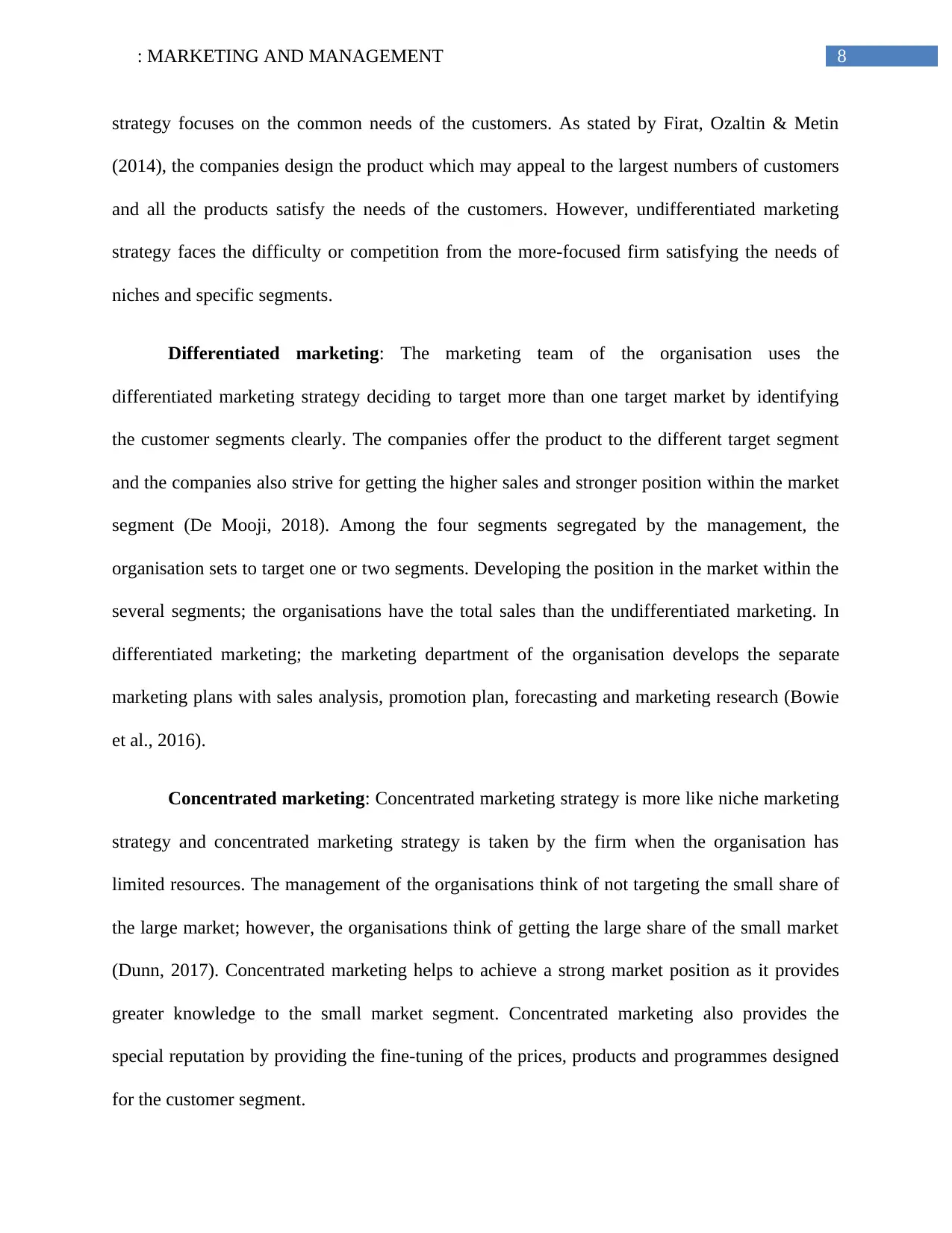
8: MARKETING AND MANAGEMENT
strategy focuses on the common needs of the customers. As stated by Firat, Ozaltin & Metin
(2014), the companies design the product which may appeal to the largest numbers of customers
and all the products satisfy the needs of the customers. However, undifferentiated marketing
strategy faces the difficulty or competition from the more-focused firm satisfying the needs of
niches and specific segments.
Differentiated marketing: The marketing team of the organisation uses the
differentiated marketing strategy deciding to target more than one target market by identifying
the customer segments clearly. The companies offer the product to the different target segment
and the companies also strive for getting the higher sales and stronger position within the market
segment (De Mooji, 2018). Among the four segments segregated by the management, the
organisation sets to target one or two segments. Developing the position in the market within the
several segments; the organisations have the total sales than the undifferentiated marketing. In
differentiated marketing; the marketing department of the organisation develops the separate
marketing plans with sales analysis, promotion plan, forecasting and marketing research (Bowie
et al., 2016).
Concentrated marketing: Concentrated marketing strategy is more like niche marketing
strategy and concentrated marketing strategy is taken by the firm when the organisation has
limited resources. The management of the organisations think of not targeting the small share of
the large market; however, the organisations think of getting the large share of the small market
(Dunn, 2017). Concentrated marketing helps to achieve a strong market position as it provides
greater knowledge to the small market segment. Concentrated marketing also provides the
special reputation by providing the fine-tuning of the prices, products and programmes designed
for the customer segment.
strategy focuses on the common needs of the customers. As stated by Firat, Ozaltin & Metin
(2014), the companies design the product which may appeal to the largest numbers of customers
and all the products satisfy the needs of the customers. However, undifferentiated marketing
strategy faces the difficulty or competition from the more-focused firm satisfying the needs of
niches and specific segments.
Differentiated marketing: The marketing team of the organisation uses the
differentiated marketing strategy deciding to target more than one target market by identifying
the customer segments clearly. The companies offer the product to the different target segment
and the companies also strive for getting the higher sales and stronger position within the market
segment (De Mooji, 2018). Among the four segments segregated by the management, the
organisation sets to target one or two segments. Developing the position in the market within the
several segments; the organisations have the total sales than the undifferentiated marketing. In
differentiated marketing; the marketing department of the organisation develops the separate
marketing plans with sales analysis, promotion plan, forecasting and marketing research (Bowie
et al., 2016).
Concentrated marketing: Concentrated marketing strategy is more like niche marketing
strategy and concentrated marketing strategy is taken by the firm when the organisation has
limited resources. The management of the organisations think of not targeting the small share of
the large market; however, the organisations think of getting the large share of the small market
(Dunn, 2017). Concentrated marketing helps to achieve a strong market position as it provides
greater knowledge to the small market segment. Concentrated marketing also provides the
special reputation by providing the fine-tuning of the prices, products and programmes designed
for the customer segment.
⊘ This is a preview!⊘
Do you want full access?
Subscribe today to unlock all pages.

Trusted by 1+ million students worldwide
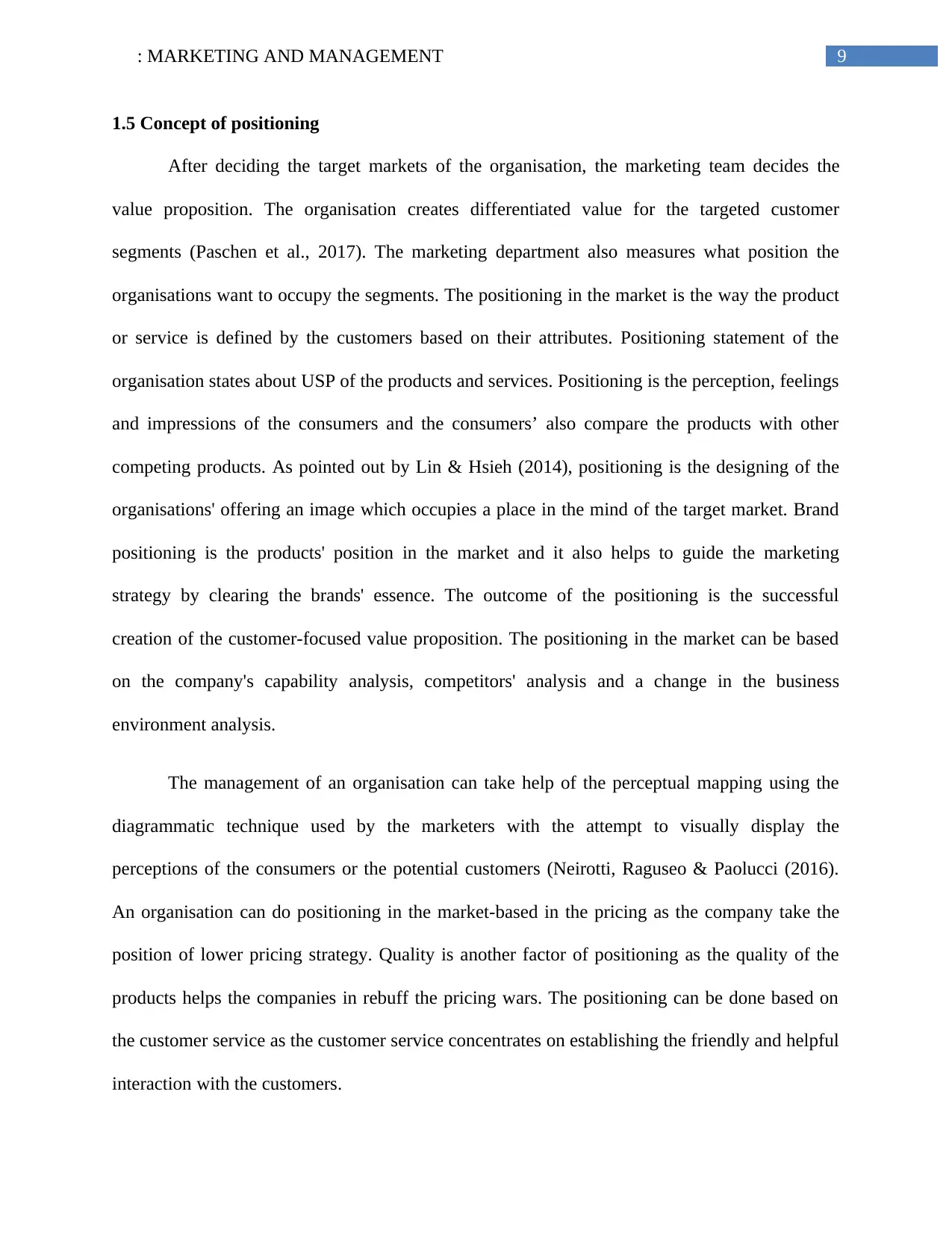
9: MARKETING AND MANAGEMENT
1.5 Concept of positioning
After deciding the target markets of the organisation, the marketing team decides the
value proposition. The organisation creates differentiated value for the targeted customer
segments (Paschen et al., 2017). The marketing department also measures what position the
organisations want to occupy the segments. The positioning in the market is the way the product
or service is defined by the customers based on their attributes. Positioning statement of the
organisation states about USP of the products and services. Positioning is the perception, feelings
and impressions of the consumers and the consumers’ also compare the products with other
competing products. As pointed out by Lin & Hsieh (2014), positioning is the designing of the
organisations' offering an image which occupies a place in the mind of the target market. Brand
positioning is the products' position in the market and it also helps to guide the marketing
strategy by clearing the brands' essence. The outcome of the positioning is the successful
creation of the customer-focused value proposition. The positioning in the market can be based
on the company's capability analysis, competitors' analysis and a change in the business
environment analysis.
The management of an organisation can take help of the perceptual mapping using the
diagrammatic technique used by the marketers with the attempt to visually display the
perceptions of the consumers or the potential customers (Neirotti, Raguseo & Paolucci (2016).
An organisation can do positioning in the market-based in the pricing as the company take the
position of lower pricing strategy. Quality is another factor of positioning as the quality of the
products helps the companies in rebuff the pricing wars. The positioning can be done based on
the customer service as the customer service concentrates on establishing the friendly and helpful
interaction with the customers.
1.5 Concept of positioning
After deciding the target markets of the organisation, the marketing team decides the
value proposition. The organisation creates differentiated value for the targeted customer
segments (Paschen et al., 2017). The marketing department also measures what position the
organisations want to occupy the segments. The positioning in the market is the way the product
or service is defined by the customers based on their attributes. Positioning statement of the
organisation states about USP of the products and services. Positioning is the perception, feelings
and impressions of the consumers and the consumers’ also compare the products with other
competing products. As pointed out by Lin & Hsieh (2014), positioning is the designing of the
organisations' offering an image which occupies a place in the mind of the target market. Brand
positioning is the products' position in the market and it also helps to guide the marketing
strategy by clearing the brands' essence. The outcome of the positioning is the successful
creation of the customer-focused value proposition. The positioning in the market can be based
on the company's capability analysis, competitors' analysis and a change in the business
environment analysis.
The management of an organisation can take help of the perceptual mapping using the
diagrammatic technique used by the marketers with the attempt to visually display the
perceptions of the consumers or the potential customers (Neirotti, Raguseo & Paolucci (2016).
An organisation can do positioning in the market-based in the pricing as the company take the
position of lower pricing strategy. Quality is another factor of positioning as the quality of the
products helps the companies in rebuff the pricing wars. The positioning can be done based on
the customer service as the customer service concentrates on establishing the friendly and helpful
interaction with the customers.
Paraphrase This Document
Need a fresh take? Get an instant paraphrase of this document with our AI Paraphraser
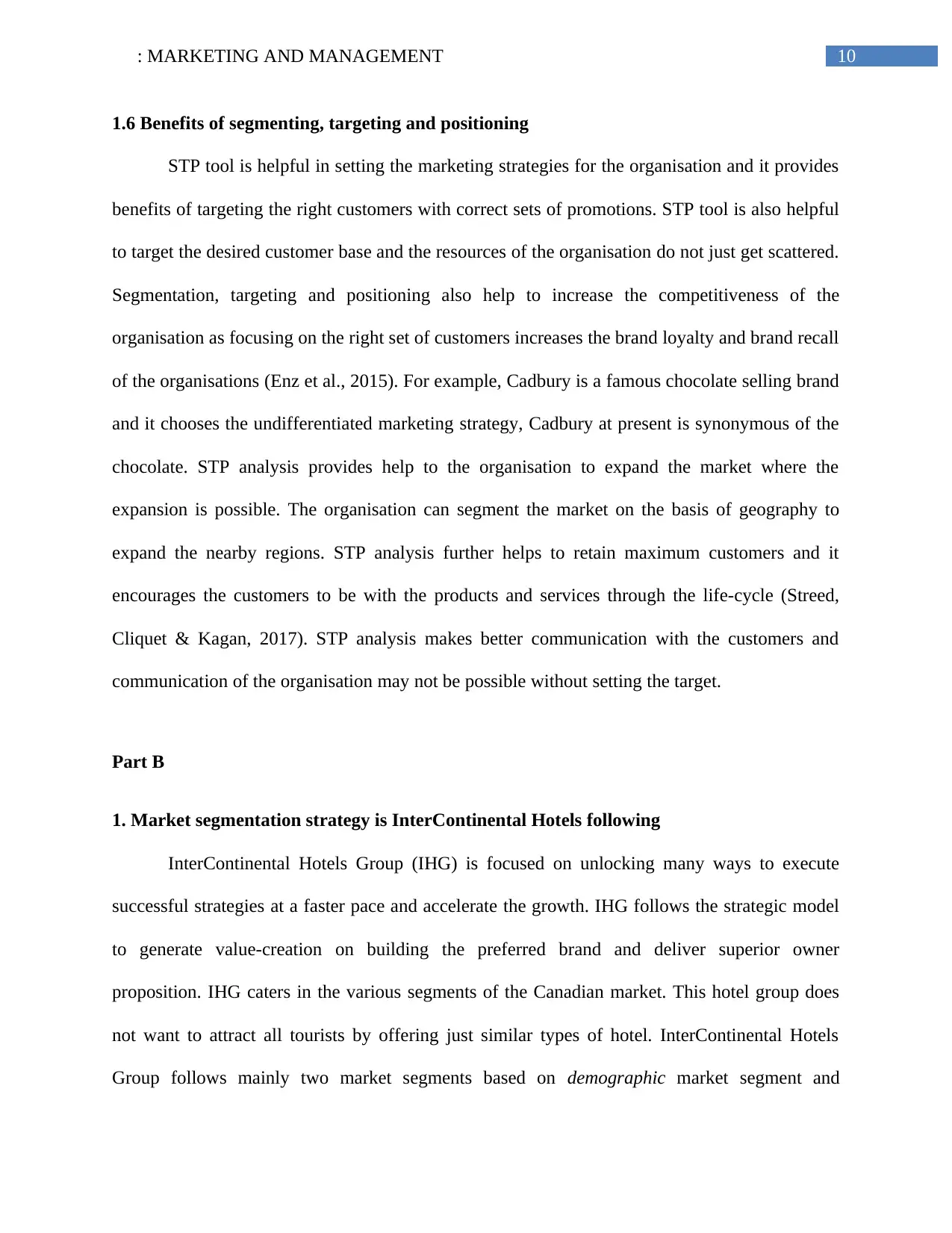
10: MARKETING AND MANAGEMENT
1.6 Benefits of segmenting, targeting and positioning
STP tool is helpful in setting the marketing strategies for the organisation and it provides
benefits of targeting the right customers with correct sets of promotions. STP tool is also helpful
to target the desired customer base and the resources of the organisation do not just get scattered.
Segmentation, targeting and positioning also help to increase the competitiveness of the
organisation as focusing on the right set of customers increases the brand loyalty and brand recall
of the organisations (Enz et al., 2015). For example, Cadbury is a famous chocolate selling brand
and it chooses the undifferentiated marketing strategy, Cadbury at present is synonymous of the
chocolate. STP analysis provides help to the organisation to expand the market where the
expansion is possible. The organisation can segment the market on the basis of geography to
expand the nearby regions. STP analysis further helps to retain maximum customers and it
encourages the customers to be with the products and services through the life-cycle (Streed,
Cliquet & Kagan, 2017). STP analysis makes better communication with the customers and
communication of the organisation may not be possible without setting the target.
Part B
1. Market segmentation strategy is InterContinental Hotels following
InterContinental Hotels Group (IHG) is focused on unlocking many ways to execute
successful strategies at a faster pace and accelerate the growth. IHG follows the strategic model
to generate value-creation on building the preferred brand and deliver superior owner
proposition. IHG caters in the various segments of the Canadian market. This hotel group does
not want to attract all tourists by offering just similar types of hotel. InterContinental Hotels
Group follows mainly two market segments based on demographic market segment and
1.6 Benefits of segmenting, targeting and positioning
STP tool is helpful in setting the marketing strategies for the organisation and it provides
benefits of targeting the right customers with correct sets of promotions. STP tool is also helpful
to target the desired customer base and the resources of the organisation do not just get scattered.
Segmentation, targeting and positioning also help to increase the competitiveness of the
organisation as focusing on the right set of customers increases the brand loyalty and brand recall
of the organisations (Enz et al., 2015). For example, Cadbury is a famous chocolate selling brand
and it chooses the undifferentiated marketing strategy, Cadbury at present is synonymous of the
chocolate. STP analysis provides help to the organisation to expand the market where the
expansion is possible. The organisation can segment the market on the basis of geography to
expand the nearby regions. STP analysis further helps to retain maximum customers and it
encourages the customers to be with the products and services through the life-cycle (Streed,
Cliquet & Kagan, 2017). STP analysis makes better communication with the customers and
communication of the organisation may not be possible without setting the target.
Part B
1. Market segmentation strategy is InterContinental Hotels following
InterContinental Hotels Group (IHG) is focused on unlocking many ways to execute
successful strategies at a faster pace and accelerate the growth. IHG follows the strategic model
to generate value-creation on building the preferred brand and deliver superior owner
proposition. IHG caters in the various segments of the Canadian market. This hotel group does
not want to attract all tourists by offering just similar types of hotel. InterContinental Hotels
Group follows mainly two market segments based on demographic market segment and
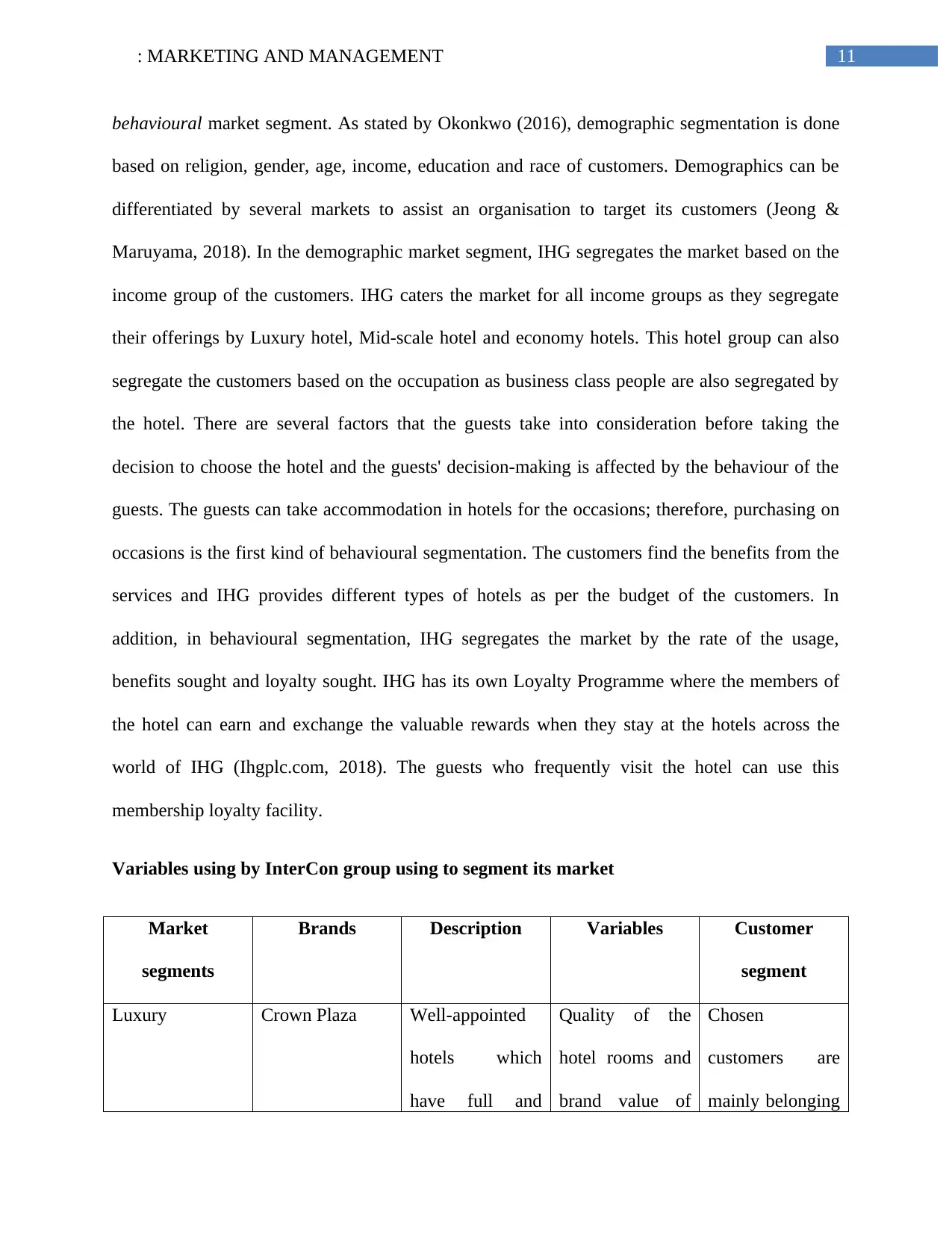
11: MARKETING AND MANAGEMENT
behavioural market segment. As stated by Okonkwo (2016), demographic segmentation is done
based on religion, gender, age, income, education and race of customers. Demographics can be
differentiated by several markets to assist an organisation to target its customers (Jeong &
Maruyama, 2018). In the demographic market segment, IHG segregates the market based on the
income group of the customers. IHG caters the market for all income groups as they segregate
their offerings by Luxury hotel, Mid-scale hotel and economy hotels. This hotel group can also
segregate the customers based on the occupation as business class people are also segregated by
the hotel. There are several factors that the guests take into consideration before taking the
decision to choose the hotel and the guests' decision-making is affected by the behaviour of the
guests. The guests can take accommodation in hotels for the occasions; therefore, purchasing on
occasions is the first kind of behavioural segmentation. The customers find the benefits from the
services and IHG provides different types of hotels as per the budget of the customers. In
addition, in behavioural segmentation, IHG segregates the market by the rate of the usage,
benefits sought and loyalty sought. IHG has its own Loyalty Programme where the members of
the hotel can earn and exchange the valuable rewards when they stay at the hotels across the
world of IHG (Ihgplc.com, 2018). The guests who frequently visit the hotel can use this
membership loyalty facility.
Variables using by InterCon group using to segment its market
Market
segments
Brands Description Variables Customer
segment
Luxury Crown Plaza Well-appointed
hotels which
have full and
Quality of the
hotel rooms and
brand value of
Chosen
customers are
mainly belonging
behavioural market segment. As stated by Okonkwo (2016), demographic segmentation is done
based on religion, gender, age, income, education and race of customers. Demographics can be
differentiated by several markets to assist an organisation to target its customers (Jeong &
Maruyama, 2018). In the demographic market segment, IHG segregates the market based on the
income group of the customers. IHG caters the market for all income groups as they segregate
their offerings by Luxury hotel, Mid-scale hotel and economy hotels. This hotel group can also
segregate the customers based on the occupation as business class people are also segregated by
the hotel. There are several factors that the guests take into consideration before taking the
decision to choose the hotel and the guests' decision-making is affected by the behaviour of the
guests. The guests can take accommodation in hotels for the occasions; therefore, purchasing on
occasions is the first kind of behavioural segmentation. The customers find the benefits from the
services and IHG provides different types of hotels as per the budget of the customers. In
addition, in behavioural segmentation, IHG segregates the market by the rate of the usage,
benefits sought and loyalty sought. IHG has its own Loyalty Programme where the members of
the hotel can earn and exchange the valuable rewards when they stay at the hotels across the
world of IHG (Ihgplc.com, 2018). The guests who frequently visit the hotel can use this
membership loyalty facility.
Variables using by InterCon group using to segment its market
Market
segments
Brands Description Variables Customer
segment
Luxury Crown Plaza Well-appointed
hotels which
have full and
Quality of the
hotel rooms and
brand value of
Chosen
customers are
mainly belonging
⊘ This is a preview!⊘
Do you want full access?
Subscribe today to unlock all pages.

Trusted by 1+ million students worldwide
1 out of 27
Related Documents
Your All-in-One AI-Powered Toolkit for Academic Success.
+13062052269
info@desklib.com
Available 24*7 on WhatsApp / Email
![[object Object]](/_next/static/media/star-bottom.7253800d.svg)
Unlock your academic potential
Copyright © 2020–2025 A2Z Services. All Rights Reserved. Developed and managed by ZUCOL.





